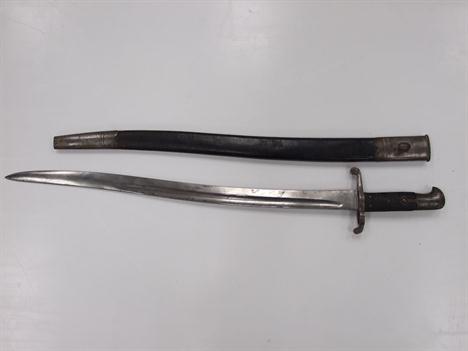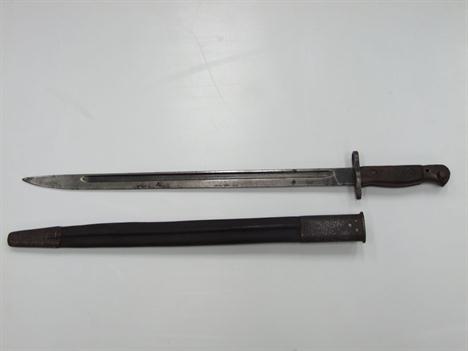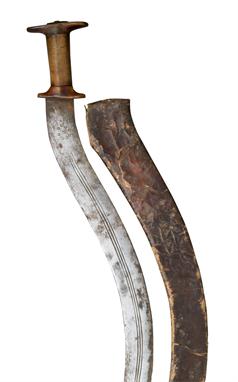We found 98577 price guide item(s) matching your search
There are 98577 lots that match your search criteria. Subscribe now to get instant access to the full price guide service.
Click here to subscribe- List
- Grid
-
98577 item(s)/page
A 19th Century Italian bayonet by Torino No`d. 3886, the leather scabbard inscribed "Terni 1886", a steel bladed chrome plated handled dagger with hatchwork grip by Anton Wingen JR Solingen, two African daggers in leather scabbards, two further sheath knives and two further decorative daggers together with a copper jam pan
A DIRK, 19TH CENTURY AND A BHUTANESE OR TIBETAN DAGGER, EARLY 20TH CENTURY the first with tapering plain blade, brass hilt including cross-guard and spherical pommel and bone grip, in its engraved brass scabbard; the second with tapering single-edged blade, white metal hilt of characteristic form, in its white metal scabbard embossed on the outer face with flowers and traditional designs the first: 31.5cm; 12 1/2in (2)
AN UNUSUAL INDO-CHINESE SWORD, LATE 19TH CENTURY with rudimentary blade cut with a slender fuller and incised with traces of a star, hilt of nimcha form, decorated with gold scrollwork (losses), shaped wooden hilt applied with an engraved silver plaque on each side, in a contemporary wooden scabbard encased in white metal, engraved over its entire surface with a running pattern of scrollwork on a hatched ground, and fitted with steel chape and suspension mounts of Chinese form 74.5cm; 29 3/8in blade
A BURMESE IVORY AND SILVER-MOUNTED DHA AND ANOTHER, SMALLER, LATE 19TH/20TH CENTURY the first with curved single-edged blade, encrusted over much of its surface with silver figures in traditional dress and inscriptions, chased silver ferrule decorated with beadwork, finely carved ivory grip pierced with an openwork design of deities and scrollwork arranged vertically, in its silver-mounted wooden scabbard; the second with short plain blade, silver ferrule, grip of tusk, in its silver-mounted scabbard the first: 57.8cm; 22 3/4in blade (2)The owner`s family state that this came from King Thibaw Min (1859-1916), the last King of the Konbaung dynasty.
TWO INDIAN DAGGERS (PESH KABZ); A MALAYSIAN DAGGER (BADE BADE); AN INDIAN KNIFE; A SOUTH-EAST ASIAN SHORTSWORD, PROBABALY MALAYSIAN; AND TWO MALAYSIAN DAGGERS (KRIS), 19TH AND 20TH CENTURIES the first two with slightly curved fullered single-edged blades, and shaped hilts formed of contrasting colours of stone; the third with pattern-welded blade (chipped), and carved grip and scabbard of characteristic form; the fourth for a commando, stamped `Princess Jodhpur` on one side, in its scabbard; the fifth, with broad single-edged chopping blade, carved wooden hilt bound with plaited silver wire over the lower portion, in its wooden scabbard open at the front and bound with silver bands; the last two of characteristic form, one with angular stylised bird`s head form grip (the other missing), and each in its scabbard the first: 35.5cm; 14in (7)
THREE INDIAN AXES AND THREE GHURKHA KUKRI KNIVES, 19TH/20TH CENTURY the first with curved axe-blade, moulded at the neck, flat rear face, on its wooden haft reinforced with strips of steel at the top; the second and third each with slender wavy axe-blade, faceted socket, and on its wooden haft; the kukris of characteristic form, each in its scabbard, and two retaining their accompanying knives the first: 53cm; 20 7/8in head (6)
AN INDIAN DAGGER (KATAR), 18TH CENTURY with sharply tapering fullered blade formed with a pronounced reinforced tip, chiselled with flowers on each side of the forte (repaired), steel hilt of characteristic form (the side-bars each repaired), including a pair of moulded grip-bars, finely chiselled over its entire surface with a vertical arrangement of gilt lotus flowers, in a leather-covered wooden scabbard 38.7cm; 15 1/4in
TWO INDIAN SWORDS (TALWARS), LATE 18TH/19TH CENTURY each with curved heavy blade, the first with russet steel hilt including a pair of quillons with flat button-shaped terminals, and retaining some gold koftgari scrolls over its surface, in its leather-covered wooden scabbard; the second with russet hilt including quillons with shaped terminals, decorated over its surface with gold border ornament and bouquets (losses), in a fabric-covered wooden scabbard the first: 83cm; 32 3/4in blade (2)
AN INDIAN SWORD (TALWAR), LATE 18TH/19TH CENTURY with curved heavy blade cut with a long fuller and double-edged towards the point, russet steel hilt of characteristic form, including recurved knuckle-guard and large disc-shaped pommel, decorated with gold flowers within an architectural framework over the greater part of its surface (losses), in a fabric-covered scabbard 73cm; 28 3/4in blade
AN INDIAN SWORD (TALWAR) WITH PRESENTATION INSCRIPTION TO MAJOR A. B. BLAXLAND, O.B.E., DATED 1933; TWO GURKHA KUKRI KNIVES; A FOLDING KNIFE; AN INDIAN `TIGER-CLAW` DAGGER (BAGH NAKH); AND AN INDIAN FOLDING KATAR, 19TH CENTURY the first with curbed single-edged blade with presentation inscription, silver-plated hilt, in its scabbard with chased silver chape; the second and third of characteristic form, one with engraved blade and horn hilt; the fourth with rudimentary locking mechanism and chequered grips (losses); the fifth decorated with gold koftgari foliage and brief inscriptions; and the last of characteristic form, decorated with silver koftgari the first: 75.2cm; 29 5/8in blade (6)
TWO CEYLONESE DAGGERS (PIHA KAETTA) AND AN INDIAN DAGGER (KHANJAR), 18TH/19TH CENTURIES the first with russet blade, the fuller inset with an engraved silver panel and applied with chased silver scrollwork on each side of the forte, the lower portion of the hilt encased in engraved brass chased with traditional scrollwork extending over the forte, silver pommel and back-strap (losses), and carved horn grips; the second similar, with plain fuller, and carved horn grip; the third with curved etched double-edged blade, and shaped steel hilt decorated with silver koftgari (losses), in its fabric-covered scabbard the first: 30.5cm; 12in (3)
A CAUCASIAN DAGGER (KINDJAL) AND TWO CONTINENTAL HUNTING KNIVES, LATE 19TH CENTURY the first with double-edged fullered blade, and horn hilt of characteristic form bound with nielloed silver and beadwork; the second with German blade, banded white metal hilt cast with scrolls and flowers, in its scabbard; the third with etched folding blade decorated with scrolling foliage inhabited by a bird and a stag and inscribed `Toledo` and steel-bound staghorn grips the first: 50cm; 19 3/4in (3)
AN OTTOMAN BALKAN SHORTSWORD (YATAGHAN), 19TH CENTURY with slightly curved single-edged blade, decorated with gold panels filled with brief inscriptions on each face, silver hilt extending over the forte, previously set with a stone in a foliate setting at the base on each side, decorated with a running pattern of foliage, shaped for the fingers and rising to an eared pommel, in a contemporary leather-covered wooden scabbard with large silver mounts decorated with panels of scrolling foliage and border ornament, and with a small loop for suspension 54cm; 21 1/4in
AN OTTOMAN SWORD (YATAGHAN), TURKEY, DATED 1251 (1835-6) with curved single-edged blade decorated with a silver calligraphic panel on one face and a decorative rondel on the other, gilt hilt extending over the lower portion of the blade and set with a red paste on each side, back-strap with shaped fluted corals in raised settings (losses), fitted with a pair of morse grip-scales retained by four rivets, rising to a shaped eared pommel (cracks), in its leather-covered wooden scabbard with large brass locket and chape embossed with scrolls, flowers and foliage, the former decorated with two broad bands of beadwork and fitted with a small loop for suspension 60.5cm; 23 3/4in bladeThe inscriptions include an invocation to Muhammad to intercede with God in Ottoman Turkish, as well as the name of the owner, possibly Ahmad Agha.
A CAUCASIAN DAGGER, LATE 19TH CENTURY with tapering fullered blade double-edged towards the point, horn hilt of kindjal form, fitted with a fluted brass ferrule at the base, in its wooden scabbard, the rear encased in steel and the front faced with brass, with two loops and a single ring for suspension 50.5cm; 19 7/8in blade
TWO CAUCASIAN SHORTSWORDS (KINDJAL), LATE 19TH/20TH CENTURY the first with broad flat fullered blade retaining traces of silver koftgari at the forte, shaped hilt of characteristic form, comprising a pair of ivory grip-scales retained by rivets on shaped brass washers, in a leather-covered wooden scabbard with chased and nielloed silver mounts, comprising lockets and chape each decorated on the outer face with symmetrical designs of foliage, and iron suspension band overlaid with chased silver; the second with fullered blade, shaped gilt and nielloed hilt, in its scabbard decorated en suite the first: 54.5cm; 21 1/2in (2)
AN OTTOMAN HARDSTONE-MOUNTED DAGGER (JAMBIYA), EARLY 19TH CENTURY, NORTH AFRICAN OR TURKISH with curved double-edged blade cut with a slender central fuller, decorated with gold koftgari scrolls enclosing a brief inscription at the forte on each face, wooden hilt of characteristic form, encased in silver and copper, the inner face chased with foliage and expanded rose heads, the outer face profusely decorated with arrangements of fluted red hardstones and turquoises in raised finely-roped settings, in its original wooden scabbard, decorated en suite with the hilt, the inner face with a small loop for suspension, and the outer with circular arrangements of hardstones 36cm; 14 1/4inKiligs and daggers of this style have been attributed to both Egypt and Turkey. See A. C. Tirri 2003, p. 67.
A PERSIAN SWORD (SHAMSHIR), LATE 18TH/19TH CENTURY with curved single-edged etched blade, steel cross-piece decorated with gold koftgari scrolls enclosing flowerheads (small losses), cap pommel, and a pair of later bone grip-scales, in a leather-covered wooden scabbard with large steel mounts decorated with gold koftgari patterns within linear frames (rubbed) 77.5cm; 30 1/2in blade
AN OTTOMAN SHAMSHIR, 18TH/EARLY 19TH CENTURY, TURKISH OR EAST EUROPEAN with curved blade of European make, double-edged towards the point, cut with three long slender fullers of differing length on each face, cut with a double eye-lash and further decorative marks at the forte, engraved white metal hilt comprising recurved cross-piece with tightly scrolling terminals, back-strap, and fitted with a pair of horn grip-scales each retained by three iron rivets (one pommel washer missing), in its leather-covered wooden scabbard with white metal mounts comprising locket, chape and middle-band all decorated with foliate borders en suite with the cross-piece and with further flowers (locket catch missing), and an additional contemporary band for suspension 85.5cm; 33 3/4in blade
AN INDO-PERSIAN DAGGER (KARD), 19TH CENTURY with etched single-edged blade, decorated with gold koftgari scrollwork on each face at the forte, slender steel hilt rising to a beaked pommel, decorated with gold en suite with the forte, in its wooden scabbard covered with blue fabric (areas of wear), with gold locket and chape decorated with matching designs of scrolls, the former fitted with a loop for suspension 33cm; 13in
A PERSIAN DAGGER (JAMBIYA), 19TH CENTURY with curved reinforced blade of watered steel, chiselled on each side of the forte with exotic animals, hardwood grip carved with calligraphic inscriptions and foliage inhabited by animals, in its leather-covered wooden scabbard with bone chape 38cm; 15in
AN ABYSSINIAN SWORD (SHOTEL), 20TH CENTURY with strongly curved fullered blade, horn hilt of characteristic form, comprising three separate pieces, and the tang retaining a coin of Vittorio Emanuele III on the top of the pommel, in its tooled leather scabbard 68cm; 26 3/4in bladeFollowing the Second Italo-Abyssinian War Vittorio Emanuele III adopted the title Emperor of Abyssinia 1936-41.
FOUR SUDANESE SWORDS (KASKARA), LATE 19TH CENTURY the first with double-edged blade stamped with a pair of celestial marks, steel cross-piece, the grip covered with crocodile skin, in its wooden scabbard engulfed by a baby crocodile; the second with etched blade; the third with fullered blade, in its leather scabbard with swollen tip; the fourth similar, with white metal cross-piece the first: 53.5cm; 21 in blade (4)
A NGALA EXECUTION KNIFE, CONGO; ANOTHER CONGO KNIFE; TWO SOMALI BILLAOU DAGGERS, LATE 19TH/20TH CENTURY; AN AFRICAN AXE; A MALAYSIAN DAGGER (BADE BADE); TWO AFRICAN BOWS; A QUIVER OF ARROWS; A NEPALESE KUKRI; AND THREE FURTHER AFRICAN DAGGERS the first with characteristically broad blade engraved with linear designs and grooved over the back-edge, moulded hilt wrapped with steel and brass ribband; the second with leaf-shaped blade pierced with two circular apertures and a slot at the hilt, incised with grooves, and shaped small wooden hilt, the third and fourth with tapering slender blades, and hilts of characteristic form composed of steel and horn; the fifth on its wooden haft; the sixth with carved ivory hilt, in its scabbard the first: 66.5cm; 26 1/4in (13)
AFRICAN WEAPONS: TWO AXES, TWO CLUBS, TWO DAGGERS, A SUDANESE SWORD (KASKARA), ANOTHER SWORD, A BOW AND ANOTHER CLUB the first axe with slender rectangular head swelling towards the tip; the second similar, on a shorter haft; the third and fourth of knobkerrie type, one bound with twisted wire, the daggers with plain blades, one with wooden anthropomorphic hilt, the other including sections of bone, each in its scabbard with a strap for the upper arm; the kaskara of characteristic form (pommel missing); the seventh with blade of kaskara type and rudimentary sheet steel stirrup hilt; the bow carved with a criss-cross pattern on the outer face (chipped); and another club, probably New Hebrides the first: 74.5cm; 29 3/8in (10)
A SUDANESE SWORD (KASKARA), LATE 19TH CENTURY with broad tapering fullered blade stamped with a pair of celestial profiles on each side, steel hilt of characteristic form, the grip covered with crocodile skin and a crocodile claw, in its wooden scabbard entirely encased in a crocodile body, fitted with a pair of rings for suspension and retaining its bound suspension cord 91cm; 35 3/4in blade
A RUSSIAN HUNTING SWORD AND FOUR SOCKET BAYONETS, 19TH CENTURY the first with tapering fullered single-edged blade, white metal hilt cast in low relief, comprising down-turned shell-guard decorated with scrolls enclosing the crowned double eagle in the centre, quillon formed as a deer`s foot, knuckle-guard and horn grip-scales, in its scabbard; the second by Wooley; the third dated 1865, in its scabbard; the fourth dated 1853, and the fifth retaining its locking ring the first: 46.5cm; 18 3/8in blade (5)
A WEST RUSSIAN SWORD (SHASQUA), LATE 19TH CENTURY AND AN INFANTRY SHORTSWORD, LATE 18TH/19TH CENTURY the first with curved fullered blade etched with patriotic inscriptions including `Vivat Szlachty`, a mounted knight and a crowned eagle displayed, struck with a cyrillic inscription on each side of the forte, brass stirrup hilt, including pierced quillon, and spirally-carved wooden grip (small cracks), in its brass-mounted brown leather scabbard; the second with tapering double-edged blade, and steel hilt including down-curved quillon, dish-guard, knuckle-guard and pommel 78.5cm; 31in blade
-
98577 item(s)/page
























































